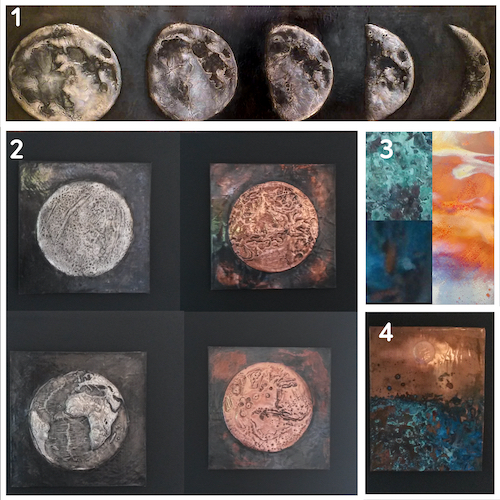"Chasing" The Planets
- Europlanet 2024 Research Infrastructure, United Kingdom of Great Britain and Northern Ireland (a.r.heward@gmail.com)
I present a series of works inspired by planetary bodies, created from copper and pewter sheet that has been worked through chasing and repoussé techniques to describe topographical relief, and with patinas and oxidation applied to add colour and contrast.
In this oral presentation, I propose to show some of the techniques and effects used in creating the works, discuss how the project has come about through a combination of personal and professional inspirations, and consider how a combination of ancient artform and kitchen chemistry can be used to look at cutting-edge planetary mission data in new ways.
Introduction
Chasing (working metal from the front) and repoussé (working metal from the back) are ancient decorative techniques that date back to at least 1600 BC[i]. When used on thin, soft, metal sheeting, detailed relief work can be achieved with a set of simple tools without need for annealing or pitch backing.
Since 2014, I have used copper and pewter sheet to create a number of works related to planetary bodies, including the Moon, terrestrial planets and the moons of Jupiter. As well as making wall-mounted panels, I have experimented with suspending double-sided 2D representations to make mobiles and decorations.
Pewter is a soft metal, composed mainly of tin, that can be worked easily from either side to create detailed relief designs. Application of an oxidising solution, via immersion or using a soft cloth, will achieve a range of tones from dull grey to black. Bright, silver-coloured highlights can be achieved through polishing.
Copper is an extremely versatile material. Its natural bright orange colour lends itself to the representation of Mars or Venus. However, heating with a blow-torch or the application of patinas can result in a wide range of colours, from pinks and yellows through to deep blues and greens [Fig. 3].
I use lead-free pewter sheet (95% Tin, 4% Antimony & 1% Copper) of 0.15mm thickness and 50cm width, and copper sheet of 0.127mm thickness and 30cm width. The sheets come in rolls of up to 2-3.5+ metres, enabling the creation of relatively large-scale installations. Application of a thin layer of lacquer to finished works prevents patinas from flaking and prevents polished metal from tarnishing.
Description of works

Phases of the Moon
I have created a number of works in pewter, ranging from around 10 cm to 1.8 metres, representing the phases of the Moon [Fig. 1]. Topography is not to scale but uses the LROC GLD100 model as a guide, as well as a range of visual images taken by ground-based observers. In interpreting the essentially black-and-white images of the Moon through the medium of oxidation of pewter, it can be a challenge to understand the respective contributions of the geology on the reflectance of the surface, and the angle of illumination in producing light and dark areas. This is a particularly important consideration when working at larger scales.
Terrestrial planets
I have created sets of individual panels representing the four terrestrial planets [Fig. 2], with Mercury and the Earth in pewter and Venus and Mars in copper. Topographical data from Messenger (Mercury), Magellan (Venus), NOAA ETOPO1 (Earth), MOLA/Mars Global Surveyor (Mars) has been used for reference in creating relief features.
Earth / exoplanets
Household ingredients and cleaning materials (salt, vinegar, ammonia, sawdust) can be used to create copper patinas ranging from a dull olive green to bright turquoise and deep blue, which can give the impression of vegetation or oceans in terrestrial landscapes [Fig. 4].
Outer planetary systems.
The range of colours produced by oxidising copper during heat treatment lends itself well to the vivid colours of Jupiter’s moon, Io. The ultramarine and turquoise colours of clouds on Neptune and Uranus may be represented through copper patinas. Over the summer, I intend to work on a series related to outer planets and their moons. My presentation will detail work in progress as well as the final versions.
[i] Metalworking through History: An Encyclopedia, By Ana M. Lopez, Pub: ABC-CLIO, 2009. pp47-48
How to cite: Heward, A.: "Chasing" The Planets, Europlanet Science Congress 2020, online, 21 September–9 Oct 2020, EPSC2020-230, https://doi.org/10.5194/epsc2020-230, 2020

